Introduction: A Munich Master of Genre
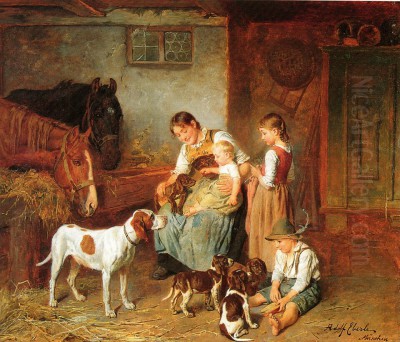
Adolf Eberle (1843–1914) stands as a significant figure in 19th-century German art, particularly associated with the Munich School. Born and trained in the Bavarian capital, Eberle dedicated his artistic career to capturing the essence of rural life, primarily focusing on the peasants, hunters, and animals of Bavaria and the neighboring Tyrol region (often referred to as Thuringian in some sources, though Tyrolean is more common for Alpine hunting scenes). His paintings are celebrated for their detailed realism, warmth, and affectionate portrayal of everyday moments, offering a valuable window into the social fabric and natural environment of his time. He excelled particularly in genre scenes and animal painting, earning considerable popularity during his lifetime and leaving a legacy of charming, meticulously rendered works.
Early Life and Artistic Formation in Munich
Adolf Eberle was born in Munich in 1843, into an environment already steeped in art. His father, Robert Eberle (1815–1860), was himself a respected painter, known particularly for his depictions of animals, especially sheep, and landscapes. This familial connection undoubtedly provided young Adolf with early exposure and foundational guidance in the visual arts. Robert Eberle's focus on animal subjects likely planted the seeds for Adolf's own later specialization in this area.
Seeking formal training, Adolf Eberle enrolled at the prestigious Royal Academy of Fine Arts in Munich (Königliche Akademie der Bildenden Künste München). This institution was a powerhouse of artistic education in German-speaking lands during the 19th century, fostering what became known as the Munich School. At the Academy, Eberle had the distinct opportunity to study under Karl von Piloty (1826–1886), one of the most influential history painters of the era. Piloty was renowned for his large-scale historical canvases, characterized by dramatic realism, meticulous detail, and often dark, rich color palettes.
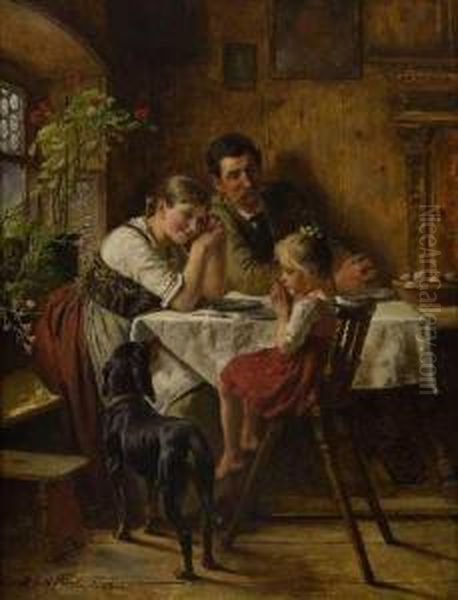
While Eberle initially engaged with history painting under Piloty's tutelage, his artistic inclinations soon shifted towards more intimate subjects. The rigorous training in realism, composition, and technique acquired under Piloty, however, provided a solid foundation for his future work. Instead of grand historical narratives, Eberle found his true calling in depicting the smaller, everyday dramas and joys of contemporary rural life. He began focusing on genre painting around the 1860s, developing a style that combined academic precision with a keen observation of human and animal behaviour.
The Heart of Bavaria: Depicting Rural Life
Eberle's primary artistic focus became the portrayal of peasant life in the Bavarian and Tyrolean Alps. He captured scenes set in rustic farmhouse interiors, mountain pastures, and village settings. His works often depict families gathered for meals, craftsmen at work, hunters returning from the chase, or quiet moments of domesticity. These paintings are more than mere observations; they often carry a sense of warmth, contentment, and the enduring values associated with rural traditions.
A quintessential example of this focus is his work often titled Tischgebet or Grace Before Meal (also referred to as Tischgebet in einer Bauernstube or The Farmhouse at Table). One version, dated 1878 and measuring 69 x 92.5 cm, was exhibited in Munich and Berlin and documented by the art historian Friedrich von Boetticher. These paintings typically show a multi-generational peasant family gathered around a simple wooden table in a cozy, rustic interior, pausing to say grace before eating. The details of the room, the traditional clothing, the varied expressions on the faces, and the interplay of light and shadow all contribute to a scene of quiet piety and familial unity. Eberle renders the textures of wood, cloth, and food with remarkable fidelity.
Another work mentioned, Grandmother Telling Stories to Granddaughter, highlights the theme of family bonds and the transmission of traditions. Such scenes, often set in comfortable, middle-class or well-to-do peasant interiors, were praised for their perceived historical authenticity and sentimental appeal. They resonated with a contemporary audience that often romanticized rural life amidst increasing industrialization and urbanization. Eberle's depictions avoided harsh social commentary, preferring instead to present an idealized yet believable vision of harmony and simple virtues. His painting Visit to the Dairy Farm, held by Kunsthaus Bühler in Stuttgart, further exemplifies this engagement with agricultural life and family activities within that context.
A Master's Touch: Eberle's Animal Painting
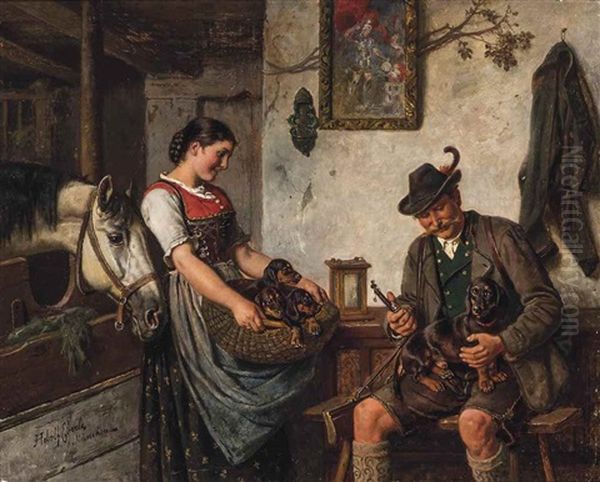
While adept at capturing human interactions, Adolf Eberle truly excelled in the depiction of animals, a skill likely nurtured by his father's own specialization. Dogs, in particular, feature prominently and are rendered with exceptional skill and empathy. He didn't just paint animals as accessories to human scenes; he often made them central figures, capturing their individual characteristics, moods, and interactions with remarkable sensitivity.
His affinity for hunting dogs is evident in numerous works. Paintings like Off to the Hunt and The Lucky Shot showcase various breeds involved in the chase, often alongside their masters, the rugged Tyrolean hunters. An Exciting Hunting Story (1886) depicts Alpine hunters, likely recounting their adventures, with their loyal canine companions attentively listening or resting nearby. These scenes allowed Eberle to combine his interest in rural customs with his talent for animal portraiture, capturing the dogs' alertness, loyalty, and physical prowess. The accuracy in depicting different breeds and their specific postures and expressions was highly admired.
Eberle also painted domestic dogs with equal affection. The Proud Dachshund (held at the Dorotheum) captures the distinctive character and physique of this popular breed. The New Family Members likely depicts the introduction of new puppies or pets into a household, playing on themes of domesticity and the affection between humans and animals. A work described as Hunter and Flannel Girl with Dog (the date 1843 likely refers to Eberle's birth year, not the painting's creation) further underscores this recurring theme of human-animal companionship in various settings. Eberle's ability to convey the textures of fur, the wetness of a nose, or the intelligent gaze in a dog's eyes contributed significantly to the appeal and perceived realism of his work.
Artistic Style and Technique: Munich School Realism
Adolf Eberle's style is firmly rooted in the traditions of the Munich School of the latter half of the 19th century. This school, heavily influenced by Dutch Golden Age painting and contemporary French realism (like that of Gustave Courbet), emphasized representational accuracy, often combined with a painterly technique and a focus on genre, landscape, and historical subjects.
Eberle's work is characterized by meticulous attention to detail. Whether depicting the rough-hewn wood of a farmhouse table, the intricate embroidery on traditional Bavarian clothing, the varied textures of animal fur, or the play of light on different surfaces, he demonstrated a high level of technical proficiency. His compositions are typically well-structured, often using interior settings to create a sense of intimacy and focus attention on the figures and their interactions.
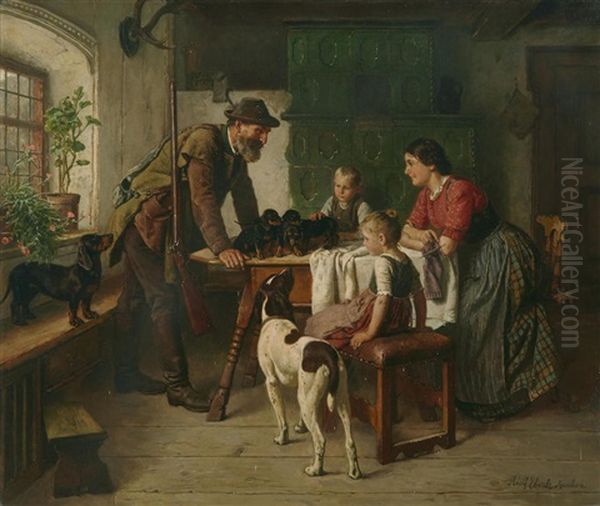
His use of color is generally rich and realistic, often employing the darker, tonal palettes favored by many Munich School painters, influenced by masters like Rembrandt. He skillfully used chiaroscuro (the contrast of light and dark) to model forms, create atmosphere, and direct the viewer's eye. While his scenes often possess an idyllic quality, the underlying realism in rendering figures, objects, and environments lends them credibility and substance. Although primarily a traditional realist, some sources suggest his later work might have subtly incorporated slightly looser brushwork or perspectives influenced by developing trends, though he remained fundamentally committed to detailed genre representation.
Career, Recognition, and Dissemination
Adolf Eberle achieved considerable success and recognition during his lifetime. He regularly exhibited his works at major venues, including the prestigious annual exhibitions at the Munich Glaspalast and the Berlin Academy exhibitions. His paintings were popular with collectors and the public, appreciated for their technical skill, relatable subjects, and sentimental charm.
The appeal of his work extended beyond original canvases. Many of his popular compositions, particularly hunting and animal scenes like An Exciting Hunting Story, were reproduced and widely disseminated through wood engravings and later, photographic prints. This practice made his imagery accessible to a broader audience and contributed to his reputation throughout Germany and beyond.
His paintings continue to appear at auctions, demonstrating sustained market interest. The reported sale price of €5,200 for An Exciting Hunting Story at one auction reflects the value attributed to his work. Furthermore, his paintings are held in various public and private collections, including references found in historical inventories like Friedrich von Boetticher's Malerwerke des neunzehnten Jahrhunderts (Painter's Works of the Nineteenth Century) and museum or gallery holdings like the Kunsthaus Bühler. This presence confirms his established place within the canon of 19th-century German art.
Context: The Munich School and Contemporaries
To fully appreciate Adolf Eberle's contribution, it's essential to view him within the context of the vibrant Munich art scene. The Munich School was not a monolithic entity but rather a collection of artists associated with the Academy who shared certain tendencies, particularly towards realism and specific subject matter.
Eberle's direct lineage connects him to his father, Robert Eberle, an established animal painter, and his teacher, Karl von Piloty, the leading figure of Munich history painting. Among Piloty's other students was Franz von Defregger (1835–1921), who, like Eberle, turned to genre scenes, specializing in depictions of Tyrolean peasant life and historical events from the Tyrolean uprisings. While Defregger often worked on a larger scale and with more historical narrative, there are thematic parallels with Eberle's interest in Alpine rural culture.
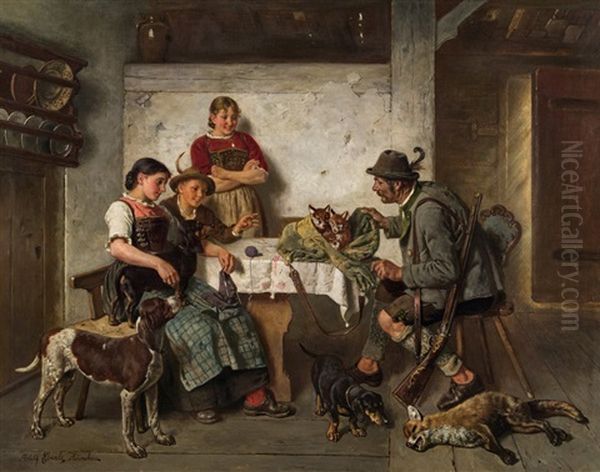
The broader Munich scene included towering figures of realism like Wilhelm Leibl (1844–1900), known for his uncompromisingly objective portraits and scenes of peasant life, often rendered with a technique influenced by French Realism and Old Masters. While Leibl's approach was perhaps more starkly realistic than Eberle's often warmer depictions, both engaged deeply with rural subjects.
Other notable Munich contemporaries in genre painting included Eduard von Grützner (1846–1925), famous for his humorous and detailed scenes of monastic life, often set in cellars and libraries. His meticulous style and focus on character studies share some common ground with Eberle's approach. The dominant portrait painter of Munich, often called the 'Prince of Painters', was Franz von Lenbach (1836–1904), known for his portraits of Bismarck and other prominent figures, representing a different facet of the Munich art world.
Looking slightly earlier, the influence of Biedermeier genre painting, exemplified by Munich artist Carl Spitzweg (1808–1885) with his charming and quirky depictions of everyday life, can be seen as a precursor to the detailed genre scenes of Eberle's generation. In the realm of animal and landscape painting, Munich also boasted artists like Friedrich Voltz (1817–1886), known for his atmospheric landscapes often featuring cattle, and later, Heinrich von Zügel (1850–1941), a leading German Impressionist animal painter who brought a more modern approach to subjects Eberle also explored.
Even earlier figures associated with the Academy, like Wilhelm von Kaulbach (1805–1874), Piloty's predecessor as director and a major figure in monumental history painting, helped establish the Academy's reputation. While Eberle moved away from such grand themes, the emphasis on technical skill remained. One might also consider the broader context of German genre painting, including influential figures from the Düsseldorf School like Ludwig Knaus (1829–1910) and Benjamin Vautier the Elder (1829–1898), whose popular depictions of rural and village life set precedents across Germany. The source material also mentions Hermann Werner (1816-1905) as a contemporary genre master, further situating Eberle within a network of artists exploring similar themes. Eberle navigated this rich artistic environment, carving out his niche with his specific focus and sensitive style.
Later Life and Enduring Legacy
Adolf Eberle remained active as a painter in Munich for most of his life. Contrary to some accounts suggesting a decline in health significantly curtailed his work long before his death (potentially confusing him with another individual), historical records confirm his death in Munich in 1914. He continued to produce works appreciated for their consistent quality and thematic focus throughout his mature career.
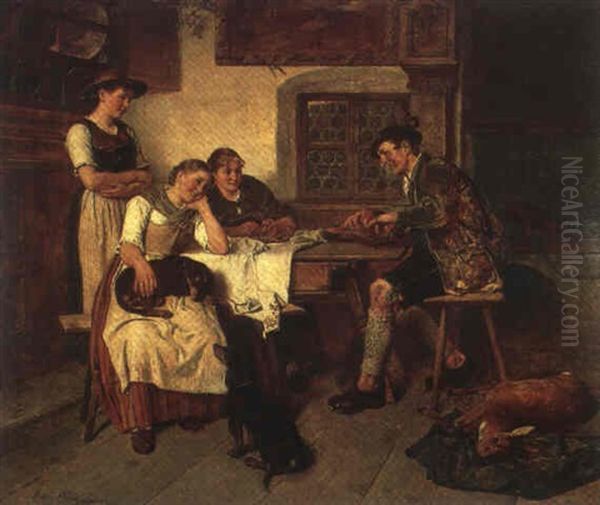
His legacy lies in his contribution to the German genre painting tradition, particularly within the Munich School. He stands out for his sympathetic and detailed portrayal of Bavarian and Tyrolean rural life and, perhaps most notably, for his exceptional skill as an animal painter. His works offer more than just picturesque scenes; they provide insight into the customs, attire, and environment of a specific region during a period of significant social change in Germany.
Eberle's paintings capture a sense of warmth, stability, and connection to nature and tradition that held great appeal for his contemporaries and continues to resonate with viewers today. His ability to render animals, especially dogs, with such personality and realism ensures his place as one of the notable German animal painters of the 19th century. Through his detailed, affectionate, and technically accomplished canvases, Adolf Eberle created an enduring visual record of a world centered around hearth, home, and the hunt in the German Alps.
Conclusion: A Painter of Heart and Hearth
Adolf Eberle remains a cherished figure among the painters of the Munich School. His dedication to depicting the everyday lives of peasants and hunters, combined with his extraordinary talent for capturing the spirit and form of animals, resulted in a body of work that is both historically informative and aesthetically pleasing. He successfully translated the rigorous academic training received under Piloty into a more intimate and accessible form of art, focusing on the warmth of family life, the bonds between humans and animals, and the rhythms of rural existence. While perhaps not a radical innovator, Eberle mastered his chosen genres, creating paintings that continue to charm viewers with their meticulous detail, narrative clarity, and heartfelt portrayal of a bygone era in the Bavarian heartland. His work endures as a testament to the enduring appeal of genre painting and the timeless connection between art and everyday life.